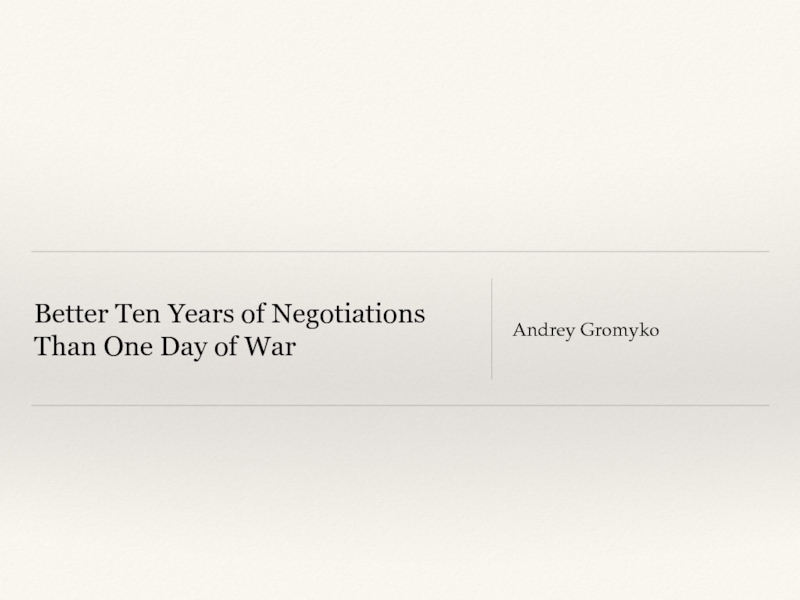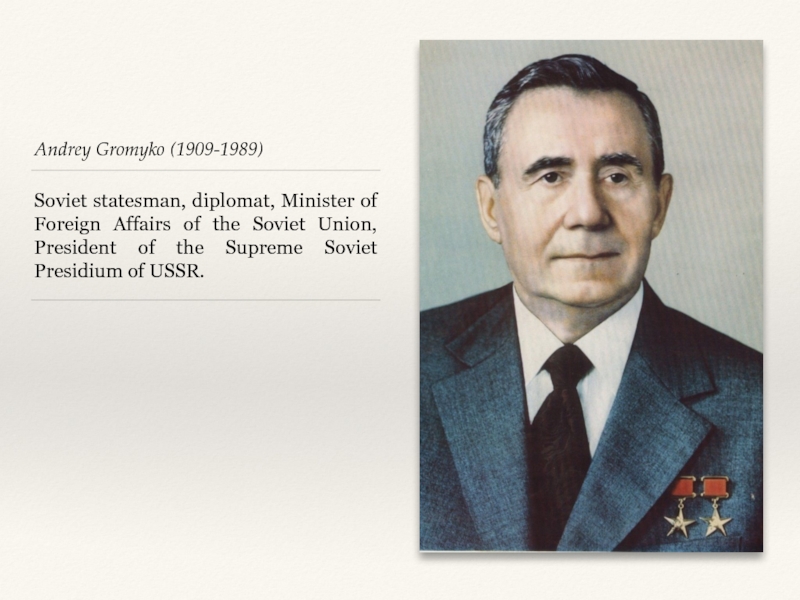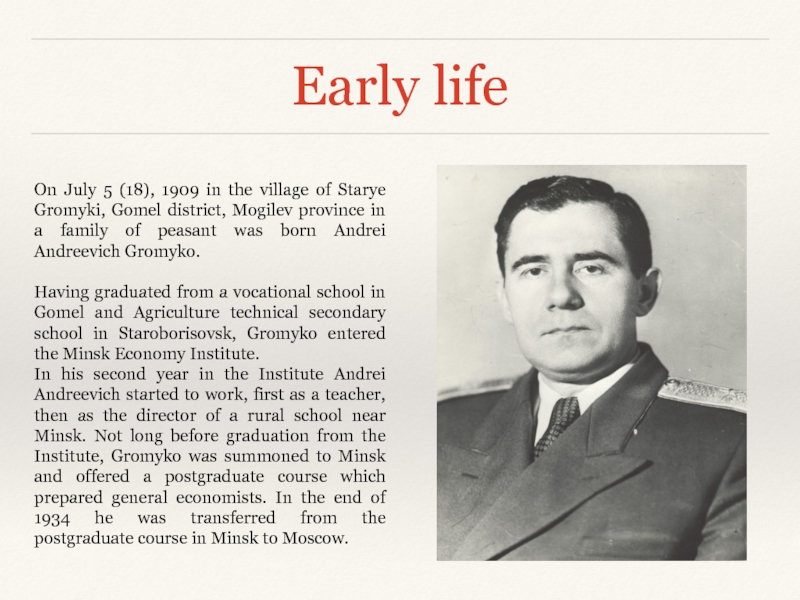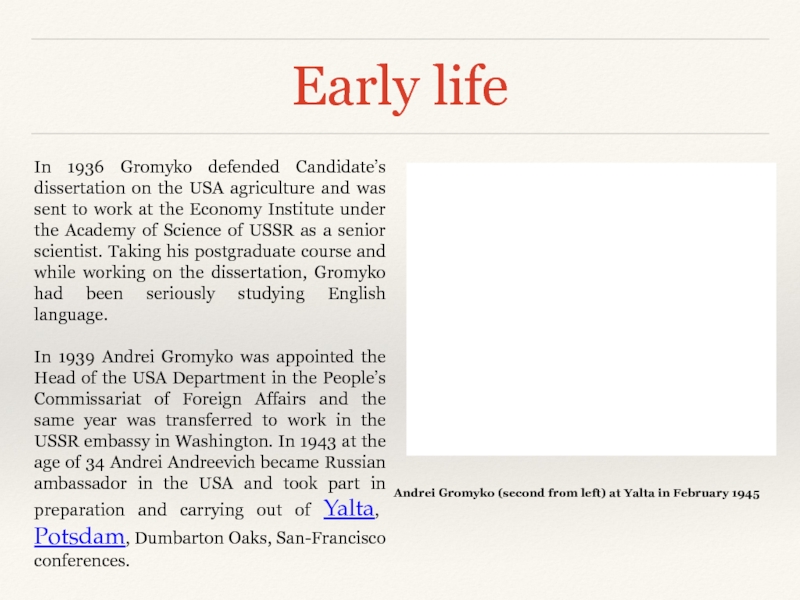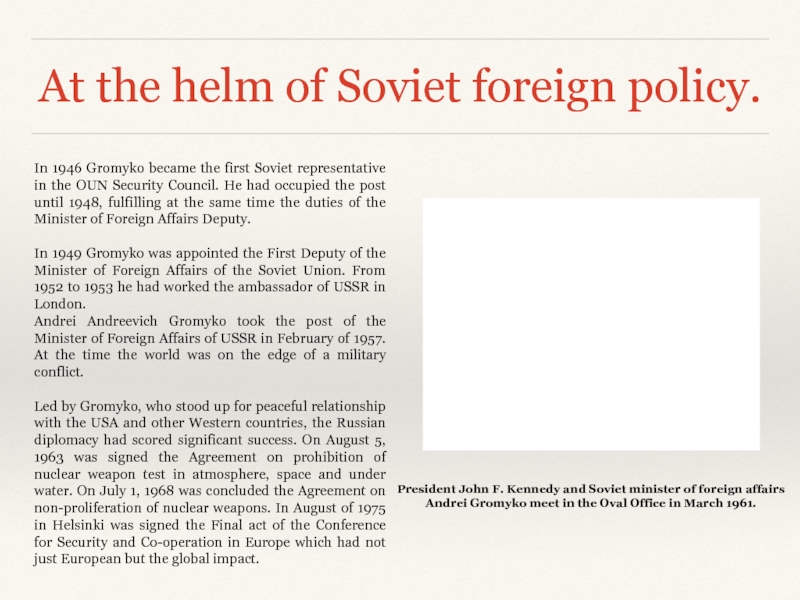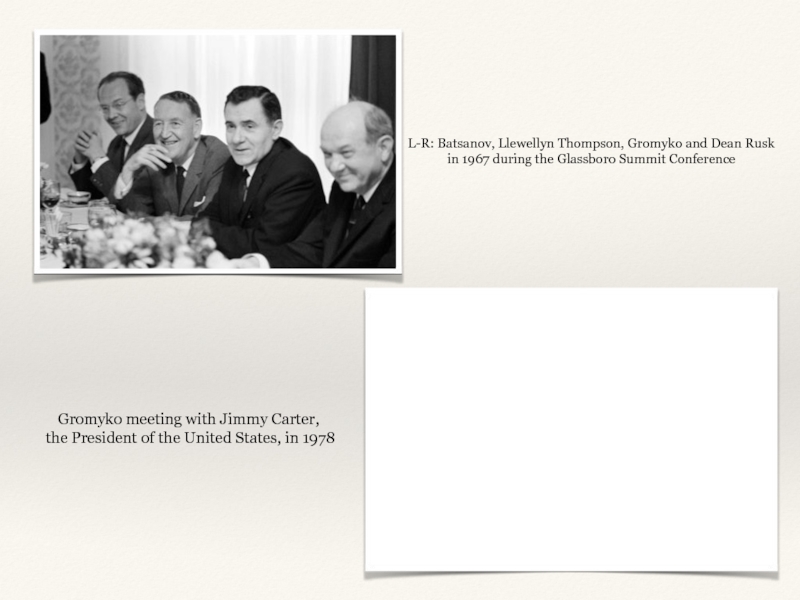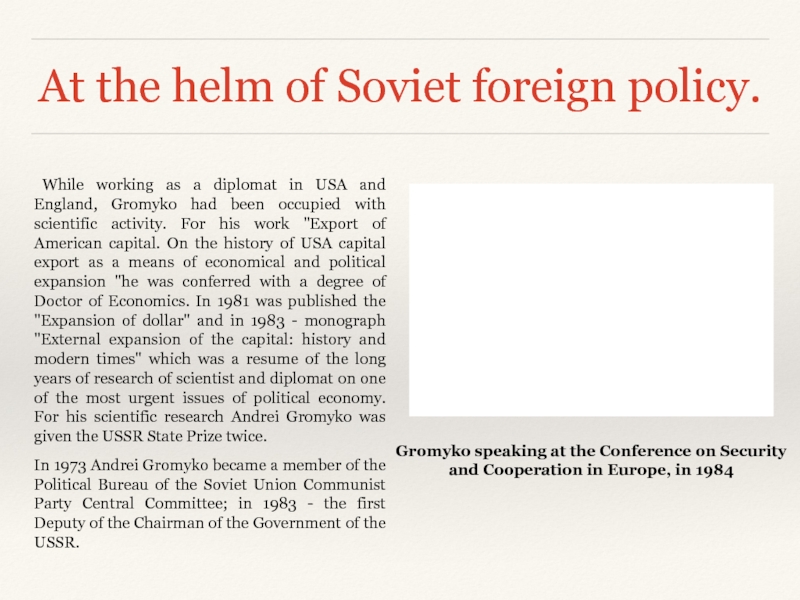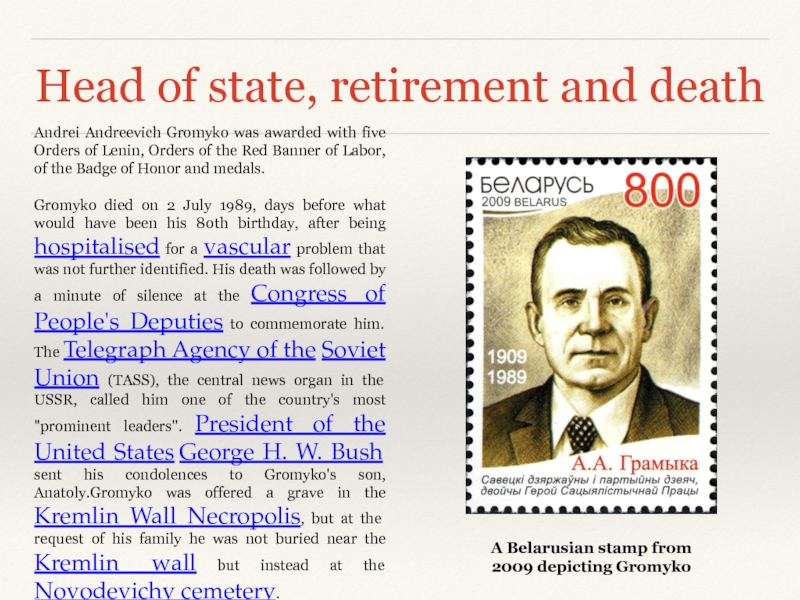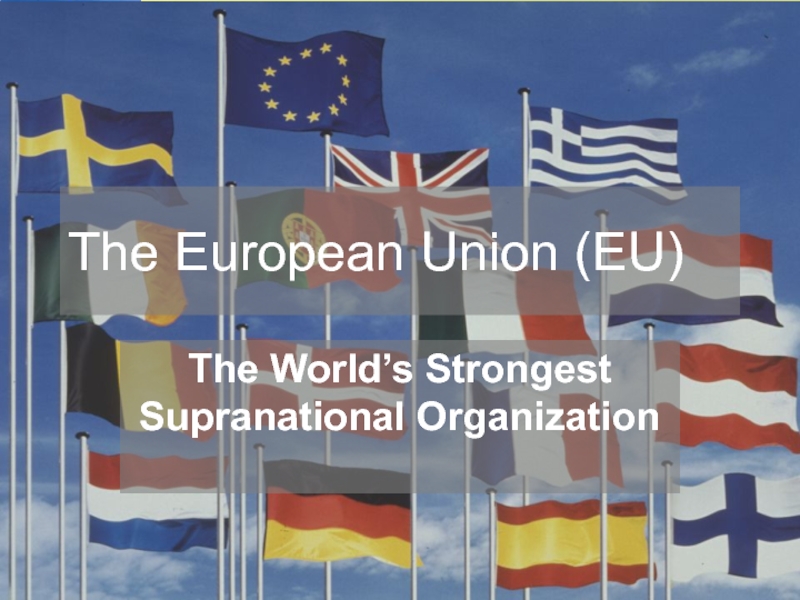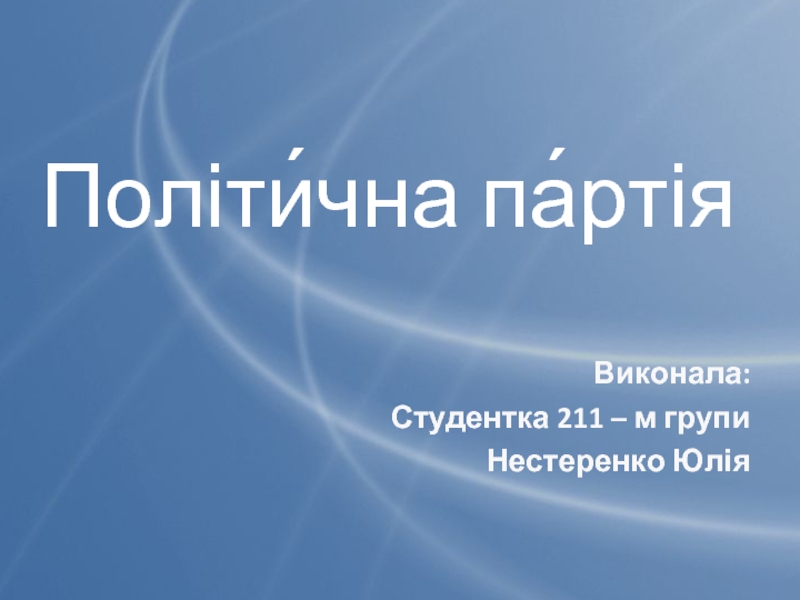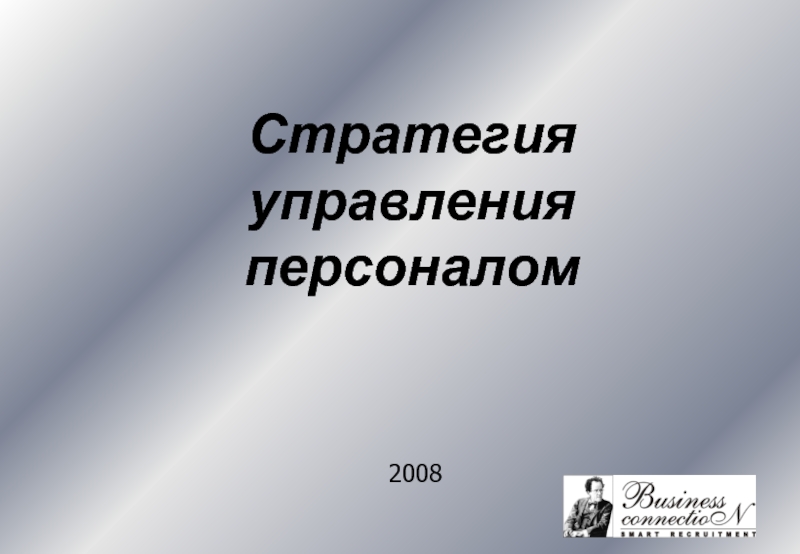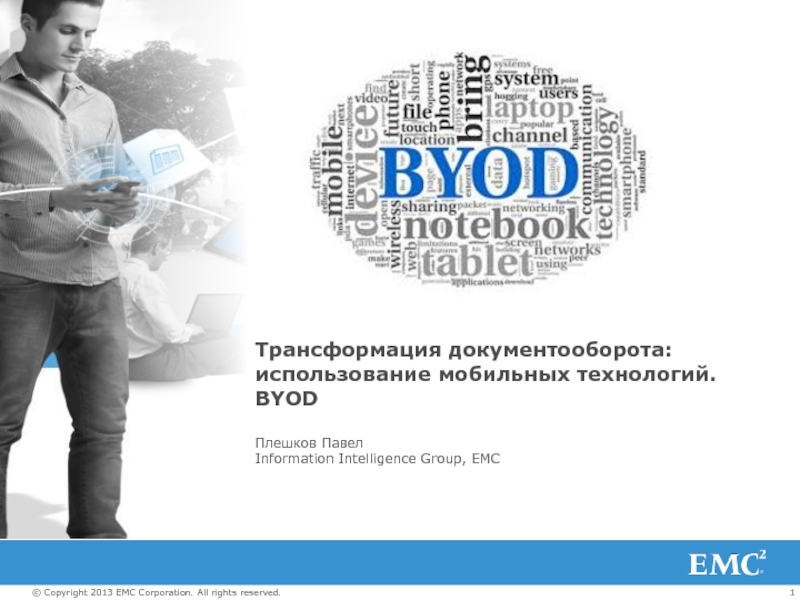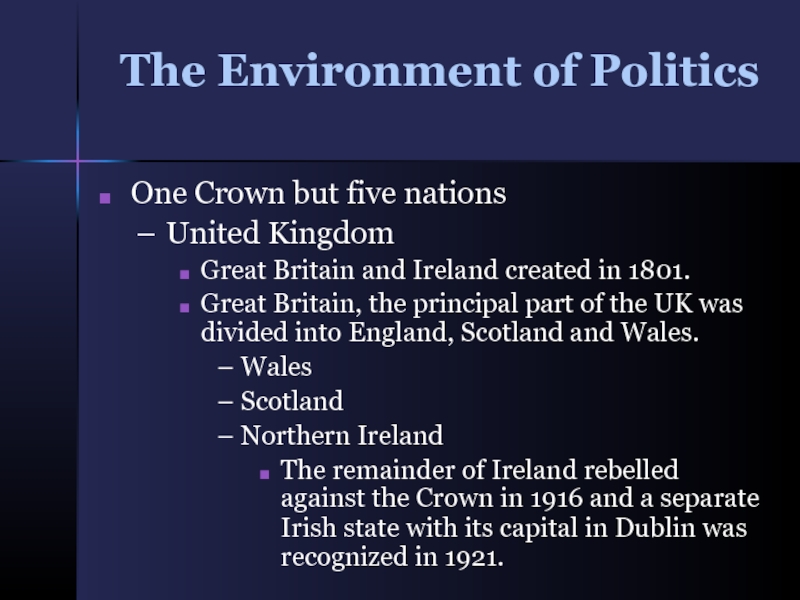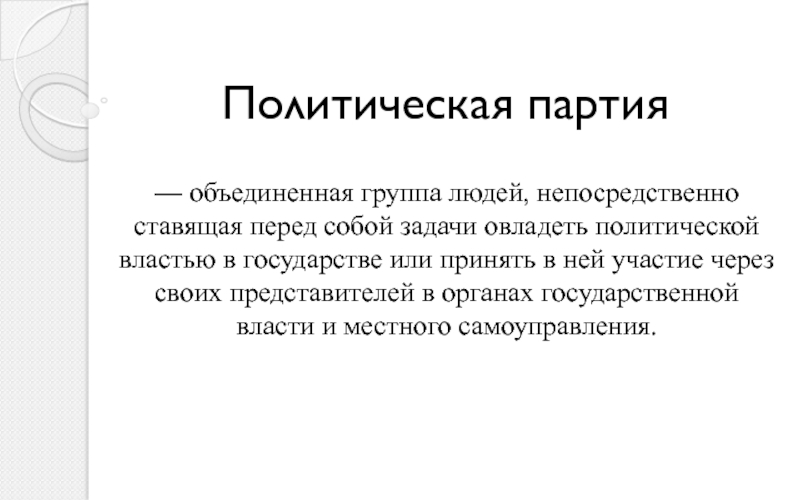- Главная
- Разное
- Дизайн
- Бизнес и предпринимательство
- Аналитика
- Образование
- Развлечения
- Красота и здоровье
- Финансы
- Государство
- Путешествия
- Спорт
- Недвижимость
- Армия
- Графика
- Культурология
- Еда и кулинария
- Лингвистика
- Английский язык
- Астрономия
- Алгебра
- Биология
- География
- Детские презентации
- Информатика
- История
- Литература
- Маркетинг
- Математика
- Медицина
- Менеджмент
- Музыка
- МХК
- Немецкий язык
- ОБЖ
- Обществознание
- Окружающий мир
- Педагогика
- Русский язык
- Технология
- Физика
- Философия
- Химия
- Шаблоны, картинки для презентаций
- Экология
- Экономика
- Юриспруденция
Better ten years of negotiations than one day of war презентация
Содержание
- 1. Better ten years of negotiations than one day of war
- 2. Andrey Gromyko (1909-1989) Soviet statesman, diplomat, Minister
- 3. Early life On July 5 (18), 1909
- 4. Early life In 1936 Gromyko defended Candidate’s
- 5. At the helm of Soviet foreign policy.
- 6. L-R: Batsanov, Llewellyn Thompson, Gromyko and Dean
- 7. At the helm of Soviet foreign policy.
- 8. Head of state, retirement and death In
- 9. Head of state, retirement and death Andrei
- 10. Thanks for your attention!
Слайд 2Andrey Gromyko (1909-1989)
Soviet statesman, diplomat, Minister of Foreign Affairs of the
Слайд 3Early life
On July 5 (18), 1909 in the village of Starye
Having graduated from a vocational school in Gomel and Agriculture technical secondary school in Staroborisovsk, Gromyko entered the Minsk Economy Institute.
In his second year in the Institute Andrei Andreevich started to work, first as a teacher, then as the director of a rural school near Minsk. Not long before graduation from the Institute, Gromyko was summoned to Minsk and offered a postgraduate course which prepared general economists. In the end of 1934 he was transferred from the postgraduate course in Minsk to Moscow.
Слайд 4Early life
In 1936 Gromyko defended Candidate’s dissertation on the USA agriculture
In 1939 Andrei Gromyko was appointed the Head of the USA Department in the People’s Commissariat of Foreign Affairs and the same year was transferred to work in the USSR embassy in Washington. In 1943 at the age of 34 Andrei Andreevich became Russian ambassador in the USA and took part in preparation and carrying out of Yalta, Potsdam, Dumbarton Oaks, San-Francisco conferences.
Andrei Gromyko (second from left) at Yalta in February 1945
Слайд 5At the helm of Soviet foreign policy.
In 1946 Gromyko became the
In 1949 Gromyko was appointed the First Deputy of the Minister of Foreign Affairs of the Soviet Union. From 1952 to 1953 he had worked the ambassador of USSR in London.
Andrei Andreevich Gromyko took the post of the Minister of Foreign Affairs of USSR in February of 1957. At the time the world was on the edge of a military conflict.
Led by Gromyko, who stood up for peaceful relationship with the USA and other Western countries, the Russian diplomacy had scored significant success. On August 5, 1963 was signed the Agreement on prohibition of nuclear weapon test in atmosphere, space and under water. On July 1, 1968 was concluded the Agreement on non-proliferation of nuclear weapons. In August of 1975 in Helsinki was signed the Final act of the Conference for Security and Co-operation in Europe which had not just European but the global impact.
President John F. Kennedy and Soviet minister of foreign affairs
Andrei Gromyko meet in the Oval Office in March 1961.
Слайд 6L-R: Batsanov, Llewellyn Thompson, Gromyko and Dean Rusk
in 1967 during
Gromyko meeting with Jimmy Carter,
the President of the United States, in 1978
Слайд 7At the helm of Soviet foreign policy.
While working as a
In 1973 Andrei Gromyko became a member of the Political Bureau of the Soviet Union Communist Party Central Committee; in 1983 - the first Deputy of the Chairman of the Government of the USSR.
Gromyko speaking at the Conference on Security
and Cooperation in Europe, in 1984
Слайд 8Head of state, retirement and death
In 1985 Andrei Gromyko left the
In supporting Gorbachev, Gromyko knew that the influence he carried would be strong.[After being voted in Gorbachev relieved Gromyko of his duty as foreign minister and replaced him with Eduard Shevardnadze and Gromyko was appointed to the largely honorary position of Chairman of the Presidium of the Supreme Soviet.
Gorbachev was formally named the leader of the Soviet Union after Gromyko's resignation. After his resignation Gorbachev praised Gromyko for his half-a-century of service to USSR. Critics, such as Alexander Belonogov the Permanent Representative of the Soviet Union to the United Nations, claimed Gromyko's foreign policy was permeated with "a spirit of intolerance and confrontation".
In October of 1988 Andrei Andreevich retired on a pension and worked on his memoirs.
Andrei Gromyko and the CPSU Central Committee General Secretary Mikhail Gorbachev during a meeting of the Politburo
Слайд 9Head of state, retirement and death
Andrei Andreevich Gromyko was awarded with
Gromyko died on 2 July 1989, days before what would have been his 80th birthday, after being hospitalised for a vascular problem that was not further identified. His death was followed by a minute of silence at the Congress of People's Deputies to commemorate him. The Telegraph Agency of the Soviet Union (TASS), the central news organ in the USSR, called him one of the country's most "prominent leaders". President of the United States George H. W. Bush sent his condolences to Gromyko's son, Anatoly.Gromyko was offered a grave in the Kremlin Wall Necropolis, but at the request of his family he was not buried near the Kremlin wall but instead at the Novodevichy cemetery.
A Belarusian stamp from 2009 depicting Gromyko
